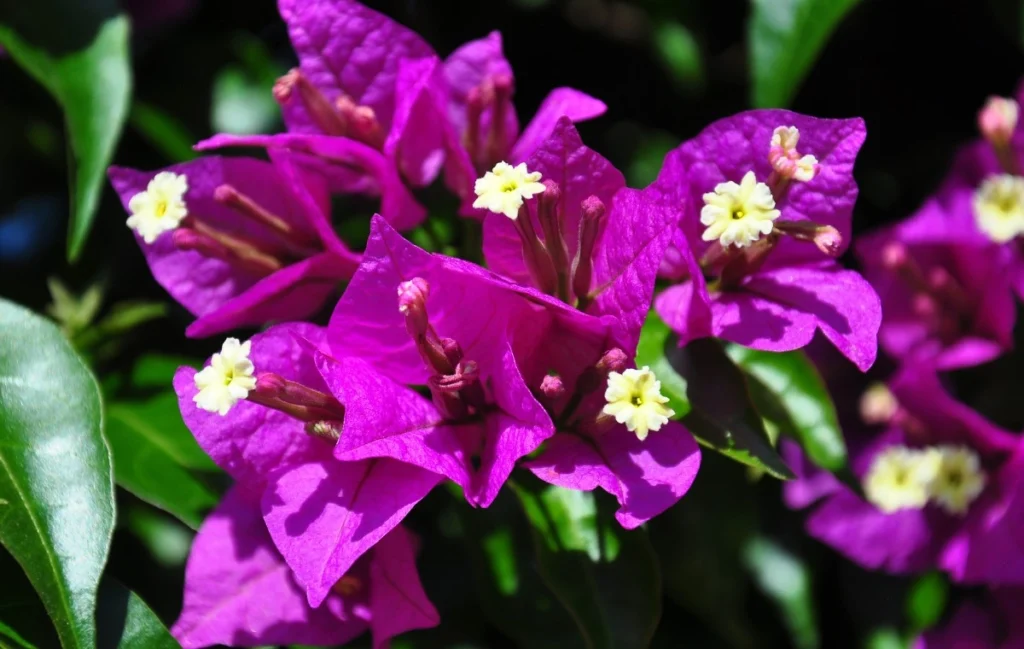The Bougainvillea glabra, commonly known as Paperflower, is a woody, climbing, and vigorous vine renowned for its abundant and spectacular blooming. Its leaves are elliptical, small, smooth, slightly elongated, and shiny, which distinguishes it from Bougainvillea spectabilis, typically featuring more ovate than elliptical leaves. However, this difference is not clearly agreed upon by researchers, who might consider merging the two species in the future.
The genus name Bougainvillea honors the French navigator Louis Antoine de Bougainville, who discovered the genus in Brazil around 1790 and took samples to Europe. The specific epithet “glabra” comes from Latin, meaning “bald,” referring to the absence of trichomes (hairs) on parts of the plant. Bougainvillea glabra is native to South America, particularly Brazil, where it is widely cultivated as an ornamental plant. In its habitat, it supports itself on large trees and emits long branches that rise above the foliage to receive sunlight. In this way, it can blend with the tree canopy and occupy its space.

The Paperflower has thorny stems with straight or slightly curved thorns. These stems can reach lengths of 5 to 15 meters (16 to 49 feet), depending on cultivation conditions and available support. The leaves of this species are alternate, with petioles approximately 1.5 cm (0.6 inches) long. The leaf blades are elliptical to lanceolate, with laminae larger than 4 cm (1.6 inches), an acute or rarely rounded base, and an acuminate or acute apex. The leaf margins are entire or wavy, with pilosity ranging from pubescent to glabrescent.
Flowering can occur year-round but tends to intensify in spring and summer. The hermaphroditic flowers are arranged in axillary or terminal inflorescences of the compound dichasium type. Each flower is surrounded by lilac or pink bracts, cordate at the base. The perianth is tubular and funnel-shaped, with a puberulent or glabrescent indumentum. The flower has 7 to 10 stamens. The ovary is fusiform, with a short, filiform, and papillose style up to the apex. Besides the colors of the type species, many varieties and cultivars now have flowers in shades of orange, yellow, white, red, as well as gradients and mixes of these colors. Variegated options, with leaves spotted with yellow, are also available.

The species is pollinated by birds and insects. The formed fruits are ellipsoid or oblong, containing seeds with a curved embryo. These fruits are anthocarps, fusiform, leathery, and have five ribs.
Bougainvillea glabra is highly versatile in landscaping, with various uses. Besides its adaptability, this plant adds significant visual impact to any garden, providing vibrant color and exuberance. As a climbing vine, it is ideal for covering pergolas, arbors, and arches, as well as crowning walls and portals. Its ability to form large masses with its colorful bracts on vertical structures creates an impressive visual effect, transforming simple elements into dramatic focal points.

When properly pruned, the Paperflower can be shaped into specific forms such as shrubs or small trees. This flexibility allows it to fit into various garden styles, from formal to natural. As a shrub, it can be used to create dense and flowering hedges, offering privacy and seasonal color. It is excellent for forming hedges, serving both functional and decorative purposes.
Bougainvillea hedges are not only effective for delimiting spaces but also attract pollinators such as bees and butterflies, contributing to garden biodiversity. In pots, the plant has adapted very well, becoming an interesting and perennial addition to hanging baskets and planters, as well as vertical gardens. This way, it adorns balconies, patios, terraces, balconies, and other places where garden soil is not accessible.
As if all these advantages were not enough, Bougainvillea glabra is one of the most common species used for the art of bonsai. Its vigorous growth and ease of pruning make it a popular choice among bonsai enthusiasts. The ability to miniaturize allows this plant to be appreciated in smaller spaces while maintaining its exuberant floral characteristics.

The Paperflower should be cultivated in fertile soil, previously prepared with slow-release chemical or organic fertilizers. It is essential that the soil is well-drained to prevent root waterlogging. It is drought-tolerant and prefers spaced watering, especially after the plant is fully established in the garden. An over-fertilized, watered, and pampered plant may exhibit great vegetative vigor but have difficulty flowering.
Bougainvillea glabra needs full sun to bloom abundantly. It withstands cold and frost better than B. spectabilis, making it more suitable for cultivation in high-altitude and subtropical areas. It prefers humid climate conditions but also tolerates drier soils and sudden temperature changes. It requires annual formative and maintenance pruning to stimulate flowering and renew part of the foliage. These prunings help control the plant’s size and promote a denser and more compact structure. As a climbing vine, it needs support for its growth, tying it against the support so it can climb properly.
Its propagation is done by seeds, layering, and cuttings. Cuttings are the most common method, using stem segments planted in suitable substrate until fully rooted. The most appropriate time for cuttings is spring, although they can be rooted during winter in warm and humid greenhouses.


